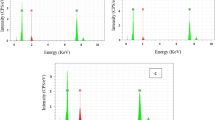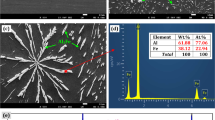Abstract
In this study, electrolytic in-process dressing (ELID) grinding experiments were conducted on SiCp/Al composites, and the effects of grinding depth and feed speed of work table on grinding force, surface roughness, and surface morphology were investigated. The experimental results showed that the fluctuation range of grinding force and grinding force ratio Cf under ELID condition were smaller than that of the same grinding parameters under wet grinding condition. Additionally, ELID grinding is effective in providing the uniformly grit protrusion and chip storage space. SiC particles were removed in ductile mode, and the brittle fracture of SiC particles were reduced substantially. The high integrity surface of the SiCp/Al composites could be obtained under ELID condition.
Similar content being viewed by others
References
Gul T, Mehtap M (2004) The drilling of an Al/SiCp metal-matrix composites: part I: microstructure. Compos Sci Technol 64:299–308
Jiao KR, Huang ST, Xu LF (2015) Feature classification of high-volume SiCp/Al composites under the condition of two-dimensional cutting based on cluster analysis theory. Int J Adv Manuf Technol 78:677–686
Manna A, Bhattacharayya B (2005) Influence of machining parameters on the machinability of particulate reinforced Al/SiC–MMC. Int J Adv Manuf Technol 25:850–856
Cui Y, Wang LF, Ren JY (2008) Multi-functional SiC/Al composites for aerospace applications. Chin J Aeronaut 21:578–584
Kunze JM, Bampton CC (2001) Challenges to developing and producing MMCs for space applications. J Occup Med 4:22–25
Suraj R (2001) Metal-matrix composites for space applications. J Occup Med 53(4):14–17
Anand RB, Vijayaraheavan L, Krishne MR (2009) Studies in the influence of grinding wheel bond material on the grindability of metal matrix composites. J Mater Des 30:679–686
Kwak JS, Kim YS (2008) Mechanical properties and grinding performance on aluminum-based metal matrix composites. J Mater Process Technol 201(1–3):596–600
Antoniomaria DI, Alfonso P (2000) A comparison between conventional abrasives and superabrasives in grinding of SiC-aluminium composites. Int J Mach Tools Manuf 40(2):173–184
Ohmori H (1993) Electrolytic in-process dressing (ELID) grinding method for ultra-precision mirror surface grinding. J Jpn Soc Precis Eng 59(9):1451
Itoh N, Ohmori H (2004) Development of metal free conductive bonded diamond wheel for environmentally-friendly electrolytic in-process dressing (ELID) grinding. New Diamond Front Carbon Technol 14(4):224–238
Senthil Kumar A, Lim HS, Rahman M, Fathima K (2002) A study on the grinding of glass using electrolytic in-process dressing. J Electron Mater 31(10):1039–1046
Saleh T, Rahman MS, Lim HS, Rahman M (2007) Development and performance evaluation of an ultra precision ELID grinding machine. J Mater Process Technol 192:287–291
Chen H, Li JCM (2000) Anodic metal matrix removal rate in electrolytic in-process dressing II: protrusion effect and three-dimensional modeling. J Appl Phys 87(6):3159–3164
Boland RJ (1999) Computer control and process monitoring of electrolytic in- process dressing of metal bond fine diamond wheels for NIF optics. Opt Manuf Test II 3782:61–69
Fathima K, Schinhaeral M, Geiss A, Rascher R, Sperber P (2010) A knowledge based feed-back control system for precision ELID grinding. Precis Eng 34:124–132
Ohmori H, Takahashi I, Bandyopadhyay BP (1996) Ultra-precision grinding of structural ceramics by electrolytic in-process dressing (ELID) grinding. J Mater Process Technol 57:272–277
Shanawaz AM, Aurtherson PB (2011) Grinding of aluminium silicon carbide metal matrix composite materials by electrolytic in-process dressing grinding. Int J Adv Manuf Technol 57:143–150
Lim HS, Fathima K, Kumar AS, Rahman M (2002) A fundamental study on the mechanism of electrolytic in-process dressing (ELID) grinding. Int J Mach Tools Manuf 42(8):935–943
Palanikumar K, Karthikeyan R (2007) Assessment of factors influencing surface roughness on the machining of Al/SiC particulate composites. Mater Des 5(28):1584–1591
Manna A, Bhattacharayya B (2003) A study on machinability of Al/SiC-MMC. J Mater Process Technol 140:711–716
Dong WP, Sullivan PJ, Stout KJ (1994) Comprehensive study of parameters for characterizing three-dimensional surface topography: parameters for characterising amplitude and some functional properties. Wear 178(l):29–43
Zhou L, Huang ST, Wang D, Yu XL (2011) Finite element and experimental studies of the cutting process of SiCp/Al composites with PCD tools. Int J Adv Manuf Technol 52:619–626
Author information
Authors and Affiliations
Corresponding author
Rights and permissions
About this article
Cite this article
Yu, X., Huang, S. & Xu, L. ELID grinding characteristics of SiCp/Al composites. Int J Adv Manuf Technol 86, 1165–1171 (2016). https://doi.org/10.1007/s00170-015-8235-3
Received:
Accepted:
Published:
Issue Date:
DOI: https://doi.org/10.1007/s00170-015-8235-3




